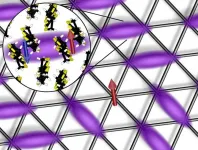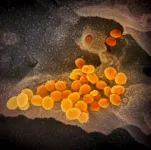Egg and sperm cell size evolved from competition
Limited resources drove gametes to differ vastly in size and number
2021-04-16
(Press-News.org) In most living animals, egg cells are vastly larger than sperm cells. In humans, for example, a single egg is 10 million times the volume of a sperm cell.
In a new study, Northwestern University researchers found that competition and natural selection drove this curious size discrepancy.
Using mathematical modeling, the researchers considered a time very early in evolution when primordial species reproduced using external fertilization. In the model, bigger reproductive cells, or gametes, presented a competitive edge because they could hold more nutrients for a potential zygote. Smaller gametes, however, required fewer resources to make, which put less stress on the parent.
"Organisms either needed to produce the biggest gametes with the most provisions or the smallest gametes to use the least resources," said Northwestern's Daniel Abrams, the study's senior author. "We believe this size difference is almost inevitable, based on plausible assumptions about how sexual reproduction works and how natural selection works."
The research was published online last night (April 15) in the Journal of Theoretical Biology.
Abrams is a professor of engineering sciences and applied mathematics at Northwestern's McCormick School of Engineering. Joseph Johnson, a Ph.D. candidate in Abrams' laboratory, is the paper's first author. Nathan White and Alain Kangabire, undergraduate students in Abrams' lab, coauthored the paper.
The Northwestern team's model begins with isogamy, a primordial state in which all gametes were roughly the same size and distinct sexes did not yet exist. The team then developed and applied a simple mathematical model to show how isogamy transitioned to anisogamy, a state where the gametes either became very small or quite large -- precursors to sperm and eggs associated with biological sexes today.
In the model, anisogamy emerged from competition to survive in an environment with limited resources. Gametes were more likely to survive if they had an edge in size over their neighbors, leading to an "arms race" favoring larger and larger gametes. But organisms could not produce many sex cells without needing more and more resources themselves. They could, however, save their resources by producing a lot of tiny gametes.
"Early in evolution when sexual reproduction emerged, gametes were symmetrical. But this is where that symmetry breaks," Abrams said. "We end up with some organisms specializing in large gametes and others specializing in small gametes."
Abrams said one remaining mystery is why some isogamist species still exist today. Some types of algae and fungi, for example, reproduce either asexually or with symmetrical mating types.
"There have been different theories about how anisogamy emerged, going all the way back to Charles Darwin," Abrams said. "Issues in evolutionary biology are very hard to test because we can only study species that are around today. We can't see what they looked like billions of years ago. Using mathematical models can yield new insight and understanding."
INFORMATION:
The research, "A dynamical model for the origin of anisogamy," was supported by the National Science Foundation (grant number 1547394).
ELSE PRESS RELEASES FROM THIS DATE:
2021-04-16
When temperatures drop below zero degrees Celsius, water turns to ice. But does everything actually freeze if you just cool it down enough? In the classical picture, matter inherently becomes solid at low temperatures. Quantum mechanics can, however, break this rule. Therefore, helium gas, for example, can become liquid at -270 degrees, but never solid under atmospheric pressure: There is no helium ice.
The same is true for the magnetic properties of materials: at sufficiently low temperatures, the magnetic moments known as 'spins', for example, arrange themselves in such a way that they are oriented opposite/antiparallel to their respective neighbors. One can think of this as arrows pointing alternating up and down along a chain or in a checkerboard pattern. It ...
2021-04-16
Snow cover in the Alps has been melting almost three days earlier per decade since the 1960s. This trend is temperature-related and cannot be compensated by heavier snowfall. By the end of the century, snow cover at 2,500 meters could disappear a month earlier than today, as simulations by environmental scientists at the University of Basel demonstrate.
Global warming demands huge adjustments in tourism, hydropower generation and agriculture in alpine areas. But the fauna and flora also have to adapt to rising temperatures. By the end of the century, ...
2021-04-16
If you are exposed to silica (quartz) dust at work - e.g. from working with concrete and granite - you have a greater risk of certain types of rheumatic disease. This is shown by results from Aarhus University and Aarhus University Hospital, which have just been published in the International Journal of Epidemiology.
Exposure to silica dust at work, which is the case especially at workplaces within construction and industry, may lead to autoimmune rheumatic diseases. Photo: Unsplash.
Exposure to silica dust at work, which is the case especially at workplaces within construction and industry, may lead to autoimmune rheumatic diseases. Photo: Unsplash.
As the research results from Aarhus University show, exposure to ...
2021-04-16
The leading newspapers in two nuclear waste management forerunner countries, Finland and France, fulfil their "watchdog" roles in highly distinct ways. The Finnish Helsingin Sanomat (HS) tends to reproduce government and industry framings, whereas Le Monde cherishes its role as an independent critic of the powers that be. These differences reflect distinct cultural, political and media traditions in the two countries.
"The critical watchdog model works in a liberal democracy such as the French, based on mistrust towards the governing elites. But would it backfire in Finland by undermining the very institutional trust that the Nordic democracies have been built upon throughout history?" asks the first author of the article, Research Fellow Markku Lehtonen from the Department of Humanities ...
2021-04-16
A new study has shown that underweight and overweight women are at a significantly higher risk of experiencing recurrent miscarriages compared to those of average weight.
A research team led by the University of Southampton assessed the link between women's lifestyle and risk of recurrent pregnancy loss, defined as women having two or more consecutive early miscarriages. The systematic review and meta-analysis study has been published in the journal Scientific Reports.
Miscarriage is the most common complication of early pregnancy, affecting 15 - 20% of all pregnancies. Recurrent pregnancy loss is a complex disease and although often attributed to numerous medical factors and lifestyle influences, the cause is deemed "unexplained" ...
2021-04-16
Tokyo, Japan - Leukemias are debilitating cancers of the hematopoietic or blood-forming cells of the bone marrow. Now, researchers at Tokyo Medical and Dental University (TMDU) describe an ingenious strategy against chronic myelomonocytic leukemia (CMML) wherein an antibody-drug conjugate (ADC) comprising a cytotoxic drug payload linked to an antibody that selectively targets specific cell lines effectively blocks malignant cell proliferation at source.
Hematopoietic stem and progenitor cells (HSPCs) continually differentiate into the entire panoply of blood cells, as many as 500 ...
2021-04-16
Since fast radio bursts (FRBs) were first discovered over a decade ago, scientists have puzzled over what could be generating these intense flashes of radio waves from outside of our galaxy. In a gradual process of elimination, the field of possible explanations has narrowed as new pieces of information are gathered about FRBs - how long they last, the frequencies of the radio waves detected, and so on.
Now, a team led by McGill University researchers and members of Canada's CHIME Fast Radio Burst collaboration has established that FRBs include radio waves at frequencies lower than ever detected before, a discovery that redraws the boundaries for theoretical astrophysicists trying to put their finger on the source of FRBs.
"We ...
2021-04-16
WHAT:
The experimental antiviral drug MK-4482 significantly decreased levels of virus and disease damage in the lungs of hamsters treated for SARS-CoV-2 infection, according to a new study from National Institutes of Health scientists. SARS-CoV-2 is the virus that causes COVID-19. MK-4482, delivered orally, is now in human clinical trials. Remdesivir, an antiviral drug already approved by the U.S. Food and Drug Administration for use against COVID-19, must be provided intravenously, making its use primarily limited to clinical settings.
In their study, published in the journal ...
2021-04-16
Artificial intelligence (AI) has sped up the process of detecting flooded buildings immediately after a large-scale flood, allowing emergency personnel to direct their efforts efficiently. Now, a research group from Tohoku University has created a machine learning (ML) model that uses news media photos to identify flooded buildings accurately within 24 hours of the disaster.
Their research was published in the journal Remote Sensing on April 5, 2021.
"Our model demonstrates how the rapid reporting of news media can speed up and increase the accuracy of damage mapping activities, accelerating ...
2021-04-16
Collaborative research of the University of Jyvaskyla and Natural Research Institute Finland presents new evidence of the effects of enriched rearing on well-being of aquaculture fishes. The research demonstrates that stone enrichments that have been previously conditioned in lake water significantly improve survival of fish compared to clean stones. Also a higher number of stones has a similar positive effect. The results have practical implications for prevention of aquaculture diseases. The study was published in Antibiotics in March 2021.
The volume of aquaculture is continuously increasing. Parasitic diseases represent a significant threat to farmed fishes and ecological solutions to minimize use of medication are being sought.
Enriched rearing, where rearing tanks ...
LAST 30 PRESS RELEASES:
[Press-News.org] Egg and sperm cell size evolved from competition
Limited resources drove gametes to differ vastly in size and number






